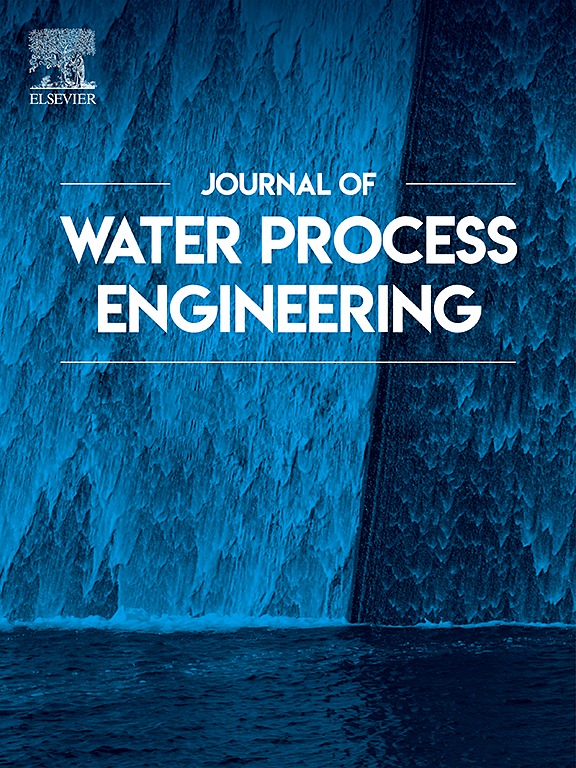Unveiling the impacts of bromide and nitrite interaction on the degradation of bisphenol A during sulfate radical oxidation
IF 6.3
2区 工程技术
Q1 ENGINEERING, CHEMICAL
引用次数: 0
Abstract
Sulfate radical (SO4•-) oxidation processes have the capacity to effectively degrade bisphenol A (BPA), an endocrine disruptor of great concern. However, potential environmental risks associated with generating harmful byproducts in this process remain largely unknown. This study revealed that nitrated byproducts were generated during the degradation of BPA by SO4•- oxidation with nitrite (NO2−) present. This is due to the production of nitrogen dioxide radical (NO2•) through the reaction of NO2− and SO4•-, which further combines with phenoxy radicals originating from BPA oxidation, leading to nitrated byproducts. Moreover, bromide (Br−) facilitated the transformation of NO2− to nitrated byproducts in this process. When 150 μM Br− and 100 μM NO2− were both in the solution, the total formation of identified nitrophenols (i.e., 2-nitrophenol, 4-nitrophenol, and 2,4-dinitrophenol) reached 0.67 ± 0.02 μM, compared to 0.55 ± 0.01 μM with NO2− alone. Nitryl bromide (NO2Br) generated from the interaction of NO2− and free bromine in situ formed from Br− oxidation was identified to play a pivotal role. It directly reacts with BPA and some intermediates via electrophilic substitution, leading to nitrated byproducts with Br− releasing. Coherently with the enhanced nitrated byproducts formation, toxicity test showed that the BPA sample treated by SO4•- in the co-presence of Br− and NO2− was more toxic than that with NO2− alone. Thus, it is required to keep a watchful eye on undesired byproducts formation when SO4•- oxidation technologies are applied in realistic environments where Br− and NO2− are commonly co-existing.
揭示了硫酸盐自由基氧化过程中溴化物和亚硝酸盐相互作用对双酚A降解的影响
硫酸盐自由基(SO4•-)氧化过程具有有效降解双酚A (BPA)的能力,双酚A是一种备受关注的内分泌干扰物。然而,在这一过程中产生有害副产品的潜在环境风险在很大程度上仍然未知。研究表明,在亚硝酸盐(NO2−)存在的情况下,SO4•-氧化降解双酚a会产生硝化副产物。这是由于二氧化氮自由基(NO2•)通过NO2−和SO4•-的反应产生,并进一步与BPA氧化产生的苯氧自由基结合,产生硝化副产物。此外,溴化物(Br−)促进了该过程中NO2−向硝化副产物的转化。当溶液中同时存在150 μM Br−和100 μM NO2−时,所识别的硝基苯酚(2-硝基苯酚、4-硝基苯酚和2,4-二硝基苯酚)的总生成量为0.67±0.02 μM,而单独存在NO2−时的总生成量为0.55±0.01 μM。硝基溴(NO2Br)是由NO2−与Br−氧化生成的原位游离溴相互作用产生的。它通过亲电取代直接与双酚a和一些中间体反应,产生具有Br−释放的硝化副产物。毒性试验结果表明,在Br−和NO2−共同存在的情况下,SO4•-处理的BPA样品毒性大于单独处理NO2−的BPA样品。因此,当在Br -和NO2 -共存的实际环境中应用SO4•-氧化技术时,需要密切关注不良副产物的形成。
本文章由计算机程序翻译,如有差异,请以英文原文为准。
求助全文
约1分钟内获得全文
求助全文
来源期刊

Journal of water process engineering
Biochemistry, Genetics and Molecular Biology-Biotechnology
CiteScore
10.70
自引率
8.60%
发文量
846
审稿时长
24 days
期刊介绍:
The Journal of Water Process Engineering aims to publish refereed, high-quality research papers with significant novelty and impact in all areas of the engineering of water and wastewater processing . Papers on advanced and novel treatment processes and technologies are particularly welcome. The Journal considers papers in areas such as nanotechnology and biotechnology applications in water, novel oxidation and separation processes, membrane processes (except those for desalination) , catalytic processes for the removal of water contaminants, sustainable processes, water reuse and recycling, water use and wastewater minimization, integrated/hybrid technology, process modeling of water treatment and novel treatment processes. Submissions on the subject of adsorbents, including standard measurements of adsorption kinetics and equilibrium will only be considered if there is a genuine case for novelty and contribution, for example highly novel, sustainable adsorbents and their use: papers on activated carbon-type materials derived from natural matter, or surfactant-modified clays and related minerals, would not fulfil this criterion. The Journal particularly welcomes contributions involving environmentally, economically and socially sustainable technology for water treatment, including those which are energy-efficient, with minimal or no chemical consumption, and capable of water recycling and reuse that minimizes the direct disposal of wastewater to the aquatic environment. Papers that describe novel ideas for solving issues related to water quality and availability are also welcome, as are those that show the transfer of techniques from other disciplines. The Journal will consider papers dealing with processes for various water matrices including drinking water (except desalination), domestic, urban and industrial wastewaters, in addition to their residues. It is expected that the journal will be of particular relevance to chemical and process engineers working in the field. The Journal welcomes Full Text papers, Short Communications, State-of-the-Art Reviews and Letters to Editors and Case Studies
 求助内容:
求助内容: 应助结果提醒方式:
应助结果提醒方式:


